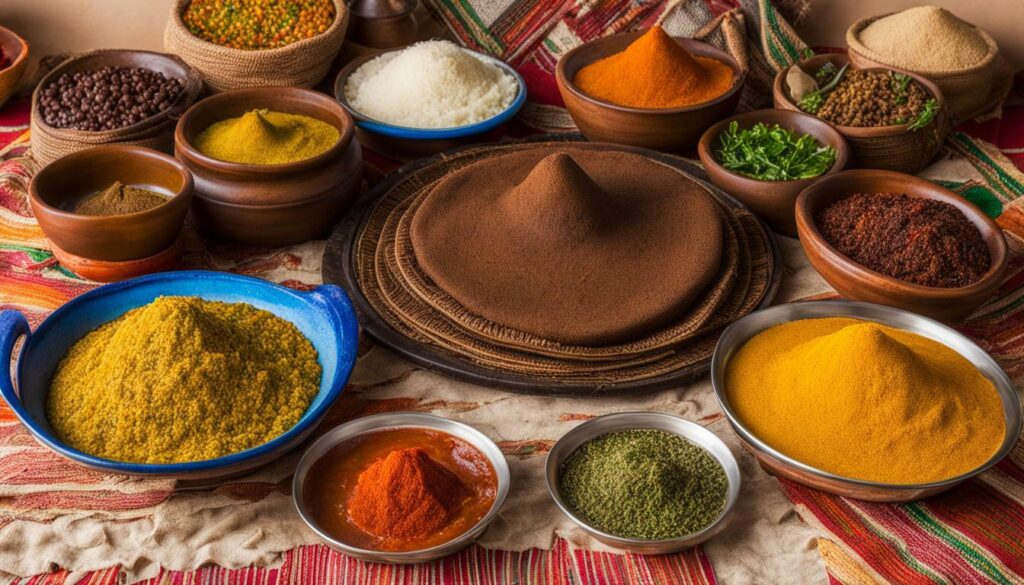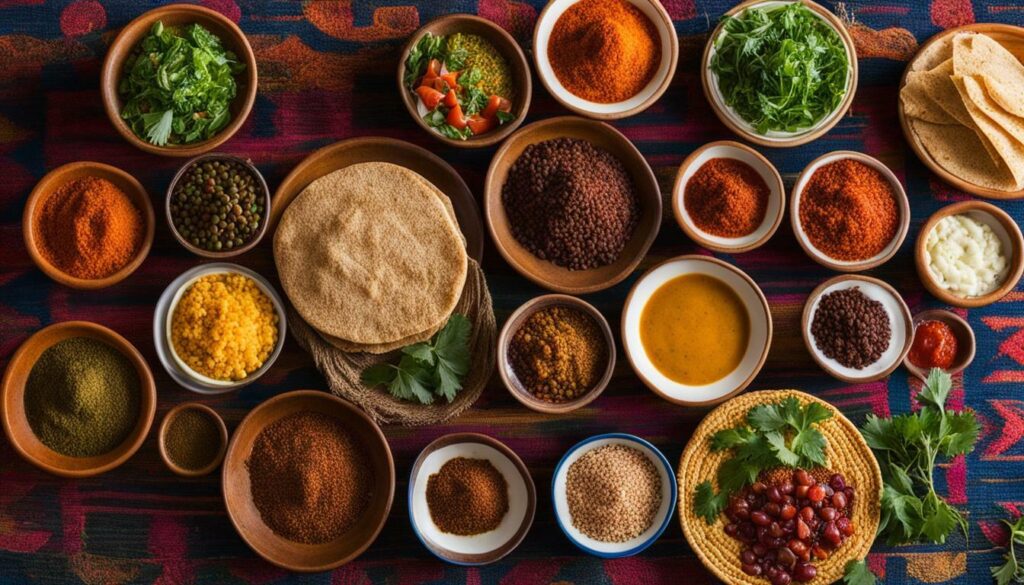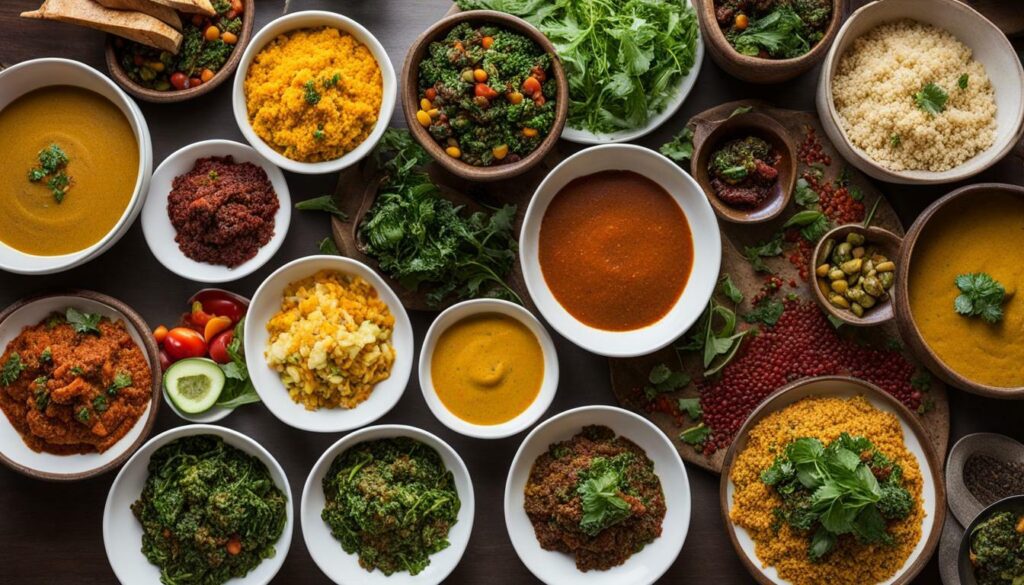The past and present diets of Ethiopia have undergone significant changes, reflecting the country’s rich history and cultural diversity.
Ethiopian cuisine has evolved over the centuries, from the explorers’ accounts of raw meat and spongy injera to the present-day practices.
In the past, Ethiopians consumed raw or half-boiled meat, seasoned with pepper and salt. They also baked their bread on embers and used tablecloths as bread.
European explorers often found Ethiopian food strange and different from their own. Today, Ethiopians no longer eat raw meat and have moved towards cooked and spiced dishes.
The consumption of meat and meat products in Ethiopia is influenced by religious beliefs. Different religious groups have their own dietary restrictions and fasting practices. For example, Ethiopian Orthodox Christians abstain from eating meat and dairy products on fasting days. The consumption of meat is closely linked to cultural practices and is prominent during special occasions. Ethiopians have a tradition of slaughtering cows or oxen and sharing the meat among the community.
In terms of diet quality, a study on Ethiopian women of reproductive age found that adherence to the Ethiopian food-based dietary guidelines was low. The newly developed Ethiopian Healthy Eating Index (Et-HEI) evaluates adherence to these guidelines and provides a score based on different components of the diet.
Overall, exploring the past and present diets of Ethiopia reveals the influence of culture, religion, and food-based dietary guidelines on the consumption patterns of Ethiopians.
Key Takeaways:
- Ethiopian cuisine has evolved over time, with significant changes in food preparation and consumption practices.
- Religious beliefs, particularly those of Ethiopian Orthodox Christians, influence the dietary choices and practices of Ethiopians.
- Cultural practices in Ethiopia, such as sharing meat during special occasions, play a significant role in the consumption of meat.
- A study on Ethiopian women of reproductive age revealed low adherence to the Ethiopian food-based dietary guidelines.
- The Ethiopian Healthy Eating Index (Et-HEI) provides a score to evaluate adherence to dietary guidelines in Ethiopia.
Ethiopian Traditional Foods
Ethiopian traditional foods offer a glimpse into the country’s culinary heritage, with unique flavours and cooking techniques. These foods have been passed down through generations, and many of them are still enjoyed today. From the staple injera, a sourdough flatbread made from teff flour, to the rich and spicy stews known as wats, Ethiopian cuisine is a delightful blend of traditional ingredients and cooking methods.
The centrepiece of an Ethiopian meal is often a large platter called a mesob, which is piled high with a variety of dishes. These dishes typically include wats, made with a variety of meats or vegetables, and often flavoured with berbere, a spicy chilli powder. Lentils, chickpeas, and split peas are also commonly used in Ethiopian cuisine, cooked into flavorful stews called wats or served as side dishes.
One popular traditional Ethiopian dish is doro wat, a spicy chicken stew made with berbere and served with injera. Another favourite is shiro, a thick and spicy stew made from ground lentils or chickpeas. Teff, the grain used to make injera, is also used to make a porridge called genfo, which is often eaten for breakfast. These traditional foods are not only delicious but also reflect the rich cultural heritage of Ethiopia.
Festive Foods in Ethiopia
Special occasions in Ethiopia are often celebrated with festive foods that are prepared with great care. One such occasion is the Ethiopian New Year, which falls on September 11th. During this holiday, families gather to enjoy a feast that includes dishes such as doro wat, kitfo (a spiced minced meat dish), and injera. Another festive occasion is the Ethiopian Christmas, known as Genna, which is celebrated on January 7th. On this day, families come together to enjoy traditional dishes like doro wat, sega wat (beef stew), and tibs (grilled meat).
It is worth noting that Ethiopian cuisine is not only delicious but also offers a wide variety of vegetarian and vegan options. Many traditional dishes are made solely with plant-based ingredients, making Ethiopian cuisine a great choice for those following a vegetarian or vegan lifestyle.

| Traditional Ethiopian Dishes | Ingredients |
|---|---|
| Doro Wat | Chicken, berbere, onions, garlic, ginger |
| Shiro | Ground lentils or chickpeas, berbere, onions, garlic |
| Kitfo | Minced raw beef or lamb, spiced butter, chilli powder |
| Tibs | Grilled meat, onions, garlic, spices |
| Injera | Teff flour, water, salt |
These are just a few examples of the many delicious traditional foods that Ethiopia has to offer. Whether you’re a meat lover or a vegetarian, there is something for everyone to enjoy in the diverse and flavorful cuisine of Ethiopia.
Influence of Religion on Ethiopian Diets
Religion plays a significant role in shaping the diets of Ethiopians, with various religious groups having their own dietary restrictions and fasting traditions. One of the major religious groups in Ethiopia is the Ethiopian Orthodox Christians. Their faith strongly influences their eating habits, particularly during the fasting periods.
The Ethiopian Orthodox Christians practice fasting as a spiritual discipline, with the aim of purifying both body and soul. These fasting periods, known as ‘tsome,’ involve abstaining from certain food groups, such as meat and dairy products. The tsome can last for several weeks and is observed at various times throughout the year, including the Great Lent and the Assumption of Mary.
During the fasting periods, Ethiopian Orthodox Christians follow a vegan diet, consuming plant-based foods such as lentils, vegetables, and grains. They also consume injera, a sourdough flatbread made from fermented teff flour, which is a staple in Ethiopian cuisine. Injera is not only a dietary choice but also holds cultural and religious significance, as it is used as a symbol of communion during religious ceremonies.

It is worth noting that fasting in Ethiopian Orthodox Christianity is a voluntary act of devotion and not a strict requirement. However, many devout Orthodox Christians adhere to these dietary restrictions as a way of honouring their faith and maintaining a strong connection to their religious community.
In summary, religion has a profound impact on the diets of Ethiopians, particularly for the Ethiopian Orthodox Christians who observe fasting periods throughout the year. These dietary restrictions not only reflect religious beliefs but also contribute to the rich culinary traditions of Ethiopia, with plant-based dishes and injera being prominent features of their cuisine.
Meat Consumption in Ethiopian Cuisine
Meat holds a prominent place in Ethiopian cuisine, with various cultural practices and traditions associated with its consumption. In the past, raw or half-boiled meat was a common part of the Ethiopian diet, often seasoned with pepper and salt. European explorers, encountering Ethiopian food for the first time, found these raw meat dishes to be unusual and different from their culinary traditions.
Today, Ethiopian cuisine has evolved, and cooked and spiced meat dishes have become more prevalent. The consumption of meat in Ethiopia is influenced by religious beliefs, with different religious groups having their own dietary restrictions and fasting practices. For instance, Ethiopian Orthodox Christians abstain from eating meat and dairy products on fasting days, adhering to their religious customs. Meat consumption is also closely linked to cultural practices and is particularly prominent during special occasions.
Traditionally, Ethiopians have a tradition of slaughtering cows or oxen and sharing the meat among the community. This communal sharing of meat is an integral part of Ethiopian culture and fosters a sense of togetherness. It is an opportunity for families and friends to come together and celebrate special moments.
| Meat of Ethiopia | Ethiopian Cuisine | National Dish in Ethiopia |
|---|---|---|
| Injera with Doro Wat | Kitfo | Tibs |
 |  |  |
“Ethiopian cuisine offers a rich and diverse array of meat dishes, reflecting the cultural heritage and flavors of the country. The spongy injera, paired with the flavorful Doro Wat, is a national favorite, while Kitfo and Tibs showcase the unique spices and techniques used in Ethiopian cooking.”
The Influence of Meat on Ethiopian National Dishes
The importance of meat in Ethiopian cuisine can be seen in the national dishes that have become synonymous with the country’s gastronomic identity. Injera, a sourdough flatbread, is often paired with Doro Wat, a spicy chicken stew, creating a delicious combination that is enjoyed by Ethiopians and visitors alike. This iconic dish represents the blend of flavours and textures that define Ethiopian cuisine.
Another staple meat dish is Kitfo, which consists of minced raw or lightly cooked beef, seasoned with spices and served with injera. The flavours of Kitfo are bold and rich, showcasing the unique spices and seasonings used in Ethiopian cooking. Tibs, a dish featuring sautéed meats, is also highly popular and is often accompanied by injera or other traditional breads.
Meat consumption in Ethiopian cuisine reflects the cultural heritage, religious practices, and culinary traditions of the country. From communal sharing of meat during special occasions to the iconic national dishes, meat plays a vital role in the diversity and richness of Ethiopian gastronomy.
Evolution of Ethiopian Bread
Ethiopian bread has transformed over time, adapting to different cooking methods and becoming an integral part of Ethiopian food culture. In the past, Ethiopians baked their bread on embers, a practice that is still carried out today in traditional households. The bread, known as injera, is made from teff, a nutritious grain native to Ethiopia. It has a sourdough-like taste and a spongy texture, making it a unique and popular staple in Ethiopian cuisine.
As Ethiopian cuisine evolved, so did the methods of baking bread. Today, injera is often prepared using a griddle or a special clay plate called a mitad. The process involves fermenting the teff flour with water for several days, creating a tangy flavour and distinctive texture. The batter is then poured onto the heated griddle or mitad, where it cooks into a large, round flatbread.
The versatility of Ethiopian bread is evident in the variety of dishes it accompanies. It serves as a utensil, where small portions of meat, vegetables, and lentils are placed on top of a large piece of injera. The diners then tear off pieces of injera and use them to scoop up the different flavours, creating a communal and interactive dining experience. This style of eating is traditional to Ethiopia and is known as “gursha,” a gesture of sharing and togetherness.
| Types of Ethiopian Bread | Description |
|---|---|
| Injera | A sourdough flatbread made from teff flour, used as a staple in Ethiopian cuisine. |
| Dabo | A slightly sweet bread made with wheat flour, often served with coffee or used as a base for sandwiches. |
| Genfo | A thick porridge-like bread made from roasted barley flour, commonly eaten for breakfast. |
| Kita | A thin and crispy bread made from wheat flour, a popular choice for breakfast or as a snack. |
With its rich history and cultural significance, Ethiopian bread continues to be cherished in the country and enjoyed by people around the world. Its unique taste, texture, and role in Ethiopian cuisine make it an essential element of any Ethiopian meal.

Dietary Guidelines in Ethiopia
The Ethiopian Healthy Eating Index (Et-HEI) provides a framework for evaluating the quality of diets based on traditional Ethiopian foods and dietary recommendations. It serves as a tool to assess the adherence to these guidelines and to promote healthier eating habits among Ethiopians.
According to the Et-HEI, typical foods of Ethiopia are rich in grains, legumes, vegetables, and fruits, which are essential components of a nutritious diet. These foods provide important vitamins, minerals, and antioxidants that support overall health. Traditional Ethiopian meals often consist of stews, known as wats, served with injera, a fermented flatbread made from teff flour.
One key aspect of the Et-HEI is the focus on minimizing the consumption of processed and unhealthy foods, such as sugary drinks, snacks high in saturated fats, and foods containing excessive amounts of added sugars and salt. The index promotes the consumption of natural and minimally processed foods, encouraging Ethiopians to prioritize whole grains, lean proteins, and plant-based ingredients in their daily meals.
| Components of the Et-HEI | Score Range |
|---|---|
| Whole grains, legumes, vegetables, and fruits | 0-10 |
| Protein foods (lean meats, fish, legumes) | 0-10 |
| Milk and dairy products | 0-10 |
| Total fat intake | 0-10 |
| Added sugars and sweetened beverages | 0-10 |
| Sodium intake | 0-10 |
“Adherence to the Ethiopian food-based dietary guidelines, as measured by the Et-HEI, is crucial for promoting better health outcomes and reducing the risk of chronic diseases,” says Dr. Alemayehu Tefera, a nutrition expert from Addis Ababa University.
The Et-HEI helps individuals and policymakers understand the components of a healthy diet and make informed choices when it comes to food consumption. It also serves as a guide for creating educational programs and policies that aim to improve the nutritional status of Ethiopians, particularly among vulnerable populations.

By highlighting the importance of traditional Ethiopian foods and encouraging the adoption of healthy dietary practices, the Et-HEI plays a significant role in promoting overall well-being and contributing to the preservation of Ethiopia’s cultural heritage through its cuisine.
Traditional Food Practices during Special Occasions
Special occasions in Ethiopia are marked by the preparation and sharing of traditional foods that hold cultural significance. These festive events bring communities together, allowing them to celebrate and showcase their rich culinary heritage. Traditional Ethiopian cuisine is known for its vibrant flavours, diverse ingredients, and unique cooking techniques.
One of the most popular dishes enjoyed during special occasions is Doro Wat, a rich and spicy chicken stew. This flavorful dish is prepared by simmering chicken with a blend of aromatic spices, including berbere (a traditional Ethiopian spice blend), onions, garlic, and ginger. Doro Wat is traditionally served with injera, a sourdough flatbread that acts as both a utensil and a staple in Ethiopian cuisine.
Another famous traditional dish that takes centre stage during festive occasions is Kitfo. Kitfo is a minced raw beef dish that is seasoned with spices and served with injera. It is often enjoyed during celebrations such as weddings and holidays. The dish symbolizes unity, as it is traditionally shared by family members and loved ones.
During these special occasions, elaborate feasts are prepared, featuring a variety of dishes that showcase the diversity of Ethiopian cuisine. The table is filled with platters of wats (stews), tibs (fried meats), and a variety of vegetable dishes. Ethiopian coffee ceremonies are also an integral part of these celebrations, where freshly roasted coffee beans are pounded, brewed, and served in a traditional clay pot called a jebena.

Traditional Ethiopian Feast Table
| Traditional Dishes | Description |
|---|---|
| Doro Wat | A spicy chicken stew made with berbere spice. |
| Kitfo | Minced raw beef seasoned with Ethiopian spices. |
| Injera | A sourdough flatbread that is used to scoop the various dishes. |
| Wats and Tibs | A variety of stews and fried meats. |
| Vegetable Dishes | An assortment of vegetarian dishes showcasing seasonal produce. |
| Ethiopian Coffee Ceremony | A traditional coffee brewing and serving ritual. |
Traditional food practices during special occasions in Ethiopia not only serve as a means of nourishment but also as a way to honour cultural traditions and strengthen community bonds. Through these culinary traditions, the rich and diverse history of Ethiopia is celebrated and passed down from generation to generation.
Evolution of Ethiopian Cuisine and European Influence
European explorers were intrigued by the unique flavours and cooking methods they encountered in Ethiopian cuisine, which differed greatly from their own. In the past, Ethiopian food practices involved consuming raw or half-boiled meat, seasoned with pepper and salt. This was a stark contrast to the European preference for cooked and well-seasoned dishes. The explorers’ accounts depicted a rich culinary tradition that showcased the resourcefulness of Ethiopian cooks in utilizing local ingredients and traditional cooking techniques.
The encounters between European explorers and Ethiopian cuisine led to the exchange of knowledge and the introduction of new ingredients and cooking methods. The explorers brought with them spices, such as cinnamon and cloves, as well as food crops like potatoes and tomatoes. These additions influenced the evolution of Ethiopian culinary traditions and resulted in a fusion of flavours and techniques that still resonate in Ethiopian cuisine today.
The impact of European influence can be seen in the use of spices and herbs, the incorporation of new cooking techniques, and the introduction of ingredients previously unknown in Ethiopia. Over time, Ethiopian dishes have become more diversified, incorporating elements from different cultures and regions. The Ethiopian cuisine we know today is a result of a fusion of traditional Ethiopian practices and European culinary influences. It is a testament to the adaptability and openness of Ethiopian cooks in embracing new flavors and techniques while preserving their rich cultural heritage.
“Ethiopian cuisine is a harmonious blend of tradition and innovation, influenced by centuries of cultural exchange and exploration.” – Ethiopian Food Historian
| European Influences | Ethiopian Culinary Traditions |
|---|---|
| Introduction of new spices | Use of local herbs and traditional spice blends |
| Introduction of new cooking techniques | Utilization of traditional cooking methods like slow simmering and fermentation |
| Introduction of new ingredients | Incorporation of indigenous crops like teff, lentils, and barley |

Evolution of Ethiopian Cuisine and European Influence
The encounters between European explorers and Ethiopian cuisine had a profound impact on the evolution of Ethiopian culinary traditions. European explorers, fascinated by the unique flavours and cooking methods they encountered, brought with them new spices, ingredients, and cooking techniques. This exchange of knowledge and ingredients led to a fusion of flavors that shaped the Ethiopian cuisine we know today.
European influences introduced new spices, such as cinnamon and cloves, which added depth and complexity to traditional Ethiopian dishes. The introduction of cooking techniques like simmering and baking further enriched the culinary repertoire of Ethiopians. Additionally, explorers brought new ingredients like potatoes and tomatoes, which were quickly incorporated into Ethiopian cooking.
However, it is important to note that Ethiopian cuisine did not simply adopt European practices. Instead, it adapted and integrated these influences into its own culinary traditions, resulting in a unique blend of flavours and techniques. The preservation of traditional Ethiopian practices, such as the use of local herbs and the utilization of indigenous crops like teff and lentils, ensured that Ethiopian cuisine retained its distinct identity.
The evolution of Ethiopian cuisine and European influence is a testament to the rich history and cultural exchange that has shaped Ethiopia’s culinary traditions. It serves as a reminder of the ingenuity and adaptability of Ethiopian cooks in embracing new flavours while preserving their culinary heritage.
Adherence to Ethiopian Food-Based Dietary Guidelines
A study on Ethiopian women of reproductive age revealed low adherence to the dietary guidelines set out by the Ethiopian government. The newly developed Ethiopian Healthy Eating Index (Et-HEI) evaluates adherence to these guidelines and provides a score based on different components of the diet. The Et-HEI assesses various aspects, including the consumption of fruits and vegetables, whole grains, dairy products, protein sources, added sugars, and saturated fats.
The study found that Ethiopian women of reproductive age scored particularly low in terms of fruit and vegetable consumption. This is concerning, as fruits and vegetables are essential sources of nutrients, vitamins, and minerals that are vital for overall health and well-being. Low intake of these food groups can contribute to nutritional deficiencies and increase the risk of chronic diseases.
“Improving adherence to the Ethiopian food-based dietary guidelines is crucial for promoting the health and well-being of the population,” says Dr. Belachew, a researcher involved in the study. “Efforts should be made to educate and empower individuals, especially women of reproductive age, to make healthier food choices and improve their overall diet quality.”
The Ethiopian government plays a significant role in promoting and disseminating information about food-based dietary guidelines. However, additional strategies and interventions are needed to increase awareness and improve adherence to these guidelines. This may include targeted nutrition education campaigns, community-based programs, and policy initiatives to ensure the availability and affordability of nutritious foods.
Improving adherence to the Ethiopian food-based dietary guidelines is not only important for individual health but also has broader implications for public health and the well-being of the population as a whole. By promoting healthier eating habits and ensuring access to nutritious foods, Ethiopia can work towards reducing the prevalence of diet-related diseases and improving the overall quality of life for its citizens.

Conclusion
The past and present diets of Ethiopia reflect a complex interplay of cultural, religious, and historical factors, with traditional foods and practices continuing to hold significance in Ethiopian cuisine. Over the centuries, Ethiopian cuisine has evolved from the explorers’ accounts of raw meat and spongy injera to present-day practices. In the past, Ethiopians consumed raw or half-boiled meat, seasoned with pepper and salt. They also baked their bread on embers and used tablecloths as bread. European explorers often found Ethiopian food strange and different from their own. Today, Ethiopians no longer eat raw meat and have moved towards cooked and spiced dishes.
The consumption of meat and meat products in Ethiopia is heavily influenced by religious beliefs. Different religious groups have their own dietary restrictions and fasting practices. For example, Ethiopian Orthodox Christians abstain from eating meat and dairy products on fasting days. The consumption of meat is also closely linked to cultural practices and is prominent during special occasions. Ethiopians have a tradition of slaughtering cows or oxen and sharing the meat among the community.
In terms of diet quality, a study on Ethiopian women of reproductive age found that adherence to the Ethiopian food-based dietary guidelines was low. The newly developed Ethiopian Healthy Eating Index (Et-HEI) evaluates adherence to these guidelines and provides a score based on different components of the diet. The study revealed a need for improved adherence to these guidelines to promote a healthier diet among the population.
Overall, exploring the past and present diets of Ethiopia highlights the influence of culture, religion, and food-based dietary guidelines on the consumption patterns of Ethiopians. While traditional foods and practices continue to be cherished, there have been changes over time, influenced by external factors such as European encounters and shifts in religious beliefs. As Ethiopia moves forward, finding a balance between preserving its rich culinary traditions and adopting healthier dietary practices will be crucial in promoting the well-being of its people.
FAQ
How has Ethiopian cuisine evolved over time?
Ethiopian cuisine has evolved from the consumption of raw or half-boiled meat to cooked and spiced dishes enjoyed today.
What are the dietary restrictions influenced by religion in Ethiopia?
Ethiopian Orthodox Christians abstain from eating meat and dairy products on fasting days.
How is the consumption of meat significant in Ethiopian culture?
Ethiopians have a tradition of slaughtering cows or oxen and sharing the meat among the community, often during special occasions.
What is the Ethiopian Healthy Eating Index (Et-HEI)?
The Ethiopian Healthy Eating Index evaluates adherence to Ethiopian food-based dietary guidelines and provides a score based on different components of the diet.
How has European influence impacted Ethiopian cuisine?
European explorers found Ethiopian food strange and different from their own, which contributed to the evolution of Ethiopian culinary traditions.
Source Links
- https://ethiopianfood.wordpress.com/2011/04/15/first-foodsteps-in-ethiopia/
- https://www.ncbi.nlm.nih.gov/pmc/articles/PMC4597829/
- https://www.ncbi.nlm.nih.gov/pmc/articles/PMC9879874/



